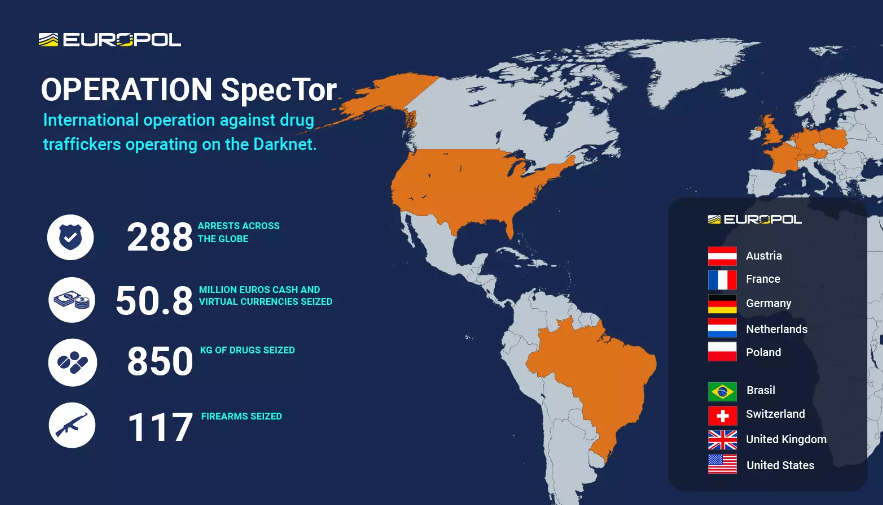
In this blog we dive into the complex challenges faced by government and law enforcement agencies in policing drug trafficking on the dark web, and how dark web investigation tools can help put cybercriminals behind bars.
The rise of drugs on the dark web
The dark web has emerged as a modern frontier for illicit activities, particularly the sale of illegal drugs. This hidden part of the internet has created a haven for drug dealers and buyers seeking anonymity. Law enforcement agencies worldwide are facing unprecedented challenges as they try to combat these underground marketplaces. In the blog we will discuss how these obstacles can be overcome with the use of dark web investigation tools.
Making a shift from traditional street-level transactions to online, anonymous marketplaces began in 2011 with the creation of online markets that exploited anonymity offered by the dark web and the use of cryptocurrencies like Bitcoin, which facilitated secure online transactions.
The first major dark web drug marketplace, SilkRoad, launched in 2011 and is widely credited with pioneering this new type of drug distribution. Founded by Ross Ulbricht, whose online alias was “Dread Pirate Roberts,” SilkRoad quickly became a hub for illegal drugs. It allowed users to browse an array of substances (including cannabis, heroin, and cocaine) while maintaining their anonymity. The dark web site operated on a trust system with user reviews and ratings, which helped buyers identify “reliable” sellers.
SilkRoad’s success was a turning point in demonstrating the viability of online drug markets. These marketplaces had a huge impact on the drug trade. Not only had it globalized the distribution of drugs, allowing buyers to access substances from around the world, it also enabled smaller dealers to reach a larger audience without the need to connect with large drug trafficking organizations.
The dark web has also introduced a perceived level of safety and convenience. Buyers could purchase drugs from their own home and have them delivered in the mail, reducing the risks associated with transactions that happen on the street.
As we look at drug sales on the dark web in the present day, according to Statista, drugs account for over 70 percent of all dark web sales, with it being the most significant contributor to the dark web’s $4.2 billion in cryptocurrency transactions.
To give you an idea of the amount of activity that happens on the dark web, at Searchlight Cyber we track over 850,000 dark web sites, and more than 100 dark web marketplaces selling illegal drugs and narcotics. These figures along with the rapid growth of dark web marketplaces has meant that law enforcement agencies have had to develop new strategies to uncover illegal drug sales.
The current challenges law enforcement face
In its annual report, the International Narcotics Control Board (INCB) recognized that the “evolving landscape of online drug trafficking is presenting new challenges to drug control,” and highlighted “the daunting task facing law enforcement authorities to monitor and prosecute online drug activities.” With that in mind, let’s explore the challenges of policing dark web drug markets across the globe.
Anonymity and encryption
One of the most significant hurdles for law enforcement is the anonymity provided by the dark web. The dark web is accessed through specialized software like Tor, which masks an individual’s IP address, making it extremely difficult to trace market accounts (of both buyers and sellers) back to individuals. Additionally, transactions on the dark web are often conducted using cryptocurrencies like Bitcoin, which adds another layer of difficulty in tracking and linking financial activity to a specific person or group.
Encryption further complicates law enforcement efforts. Communication between buyers and sellers, as well as within criminal networks, are often scrambled and encrypted, making it almost impossible for law enforcement agencies to decode messages. Even when agencies manage to gain access to dark web platforms, the encrypted data they find is often of limited use without proper keys or methods to decrypt it.
Global jurisdictional issues
The global nature of the dark web presents complex jurisdictional challenges. A drug vendor might be based in one country, host their server in another country, and ship drugs to customers worldwide. This dispersal across multiple legal jurisdictions creates a legal predicament for law enforcement agencies. Coordinating international operations (such as the Monopoly Market takedown) requires significant time and resources. Varying legal frameworks can also slow down investigations and make it easier for criminals to exploit legal loopholes.

Breakdown of Operation SpecTor across the globe
Resource limitations
Fighting dark web drug trafficking requires specialized skills, technology, and significant manpower – all of which are in limited supply for many law enforcement agencies. Cyber investigations demand a different skill set compared to traditional police work, including knowledge of hacking and digital forensics. However, the rapid pace of technological advancements means that many agencies struggle to keep their employees trained and equipped.
The volume of drug trafficking on the dark web can overwhelm even the most well-resourced agencies. With thousands of vendors and listings active at any given time, gathering actionable intelligence is a daunting task. Limited budgets and competing priorities also mean that not all law enforcement agencies can invest heavily in fighting dark web drug trafficking, leaving gaps in global enforcement efforts.
Challenges of legal prosecution
Even when law enforcement manages to arrest individuals involved in the dark web drug trade, prosecuting them can be difficult. The anonymous nature of the dark web makes it hard to prove the identity of the suspects. Evidence gathered from the dark web can be complex to present in court, especially in the jurisdictions that may lack the technical expertise to understand or validate the evidence.
Additionally, the reliance on cryptocurrency for transactions is another legal challenge. It can be difficult to link a specific wallet to a suspect, and even when financial connections are made, tracing the flow of funds can complicate prosecution.
Notable dark web markets known for drug trafficking
We’ve already touched on how SilkRoad paved the way for drug trafficking on the dark web, but let’s dig deeper into the notable dark web marketplaces that were infamous for selling drugs. As these examples show – in spite of the challenges, some of the biggest drug marketplaces have been successfully disrupted by law enforcement.
SilkRoad
As previously discussed, SilkRoad was a dark web marketplace popular for drug trafficking using cryptocurrencies such as Bitcoin. Launched in 2011, SilkRoad was eventually shut down by the FBI in 2013, and founder Ross William Ulbricht is now serving a life sentence in prison for his role in the marketplace.
The site was accessible only through Tor, allowing users to appear hidden and have the ultimate privacy from unwanted parties, such as law enforcement.
SilkRoad came to its demise in 2013 after the FBI learned about its existence. Although the federal agents admitted that the use of Tor and Bitcoin to obscure addresses were significant obstacles that they encountered, they were still able to crack down on the underground drug market.
The FBI shut down the site permanently, seized more than 144,000 bitcoins, and arrested several users of the site, including the founder, who made nearly $80 million in commissions from transactions carried out within the site.
AlphaBay
Launched in December 2014, AlphaBay was considered one of the largest dark web marketplaces selling not only drugs but stolen and fraudulent identification documents, firearms, counterfeit goods, amongst other illegal goods. At its peak, AlphaBay was used by close to 3,000 vendors to distribute illegal goods to more than 200,000 buyers throughout the world, and to launder hundreds of millions of dollars.
In July 2017, police in the US and Europe partnered to take down the site, and AlphaBay’s servers were seized with the help of authorities in Thailand, Lithuania, Canada, the United Kingdom, and France. The operation included the arrest of AlphaBay founder Alexandre Cazes who was held by the Royal Thai Police before apparently committing suicide.
The global impact of this crime requires cooperation amongst law enforcement agencies that are both well organized and timely. The takedown of AlphaBay was the result of effective cooperation between at least 11 agencies from six different countries.
How can law enforcement overcome the challenges of the dark web?
While the challenges we’ve already discussed may be unprecedented, there are solutions agencies can implement to help identify cybercriminals on the dark web and bring them to justice.
Combating anonymity and encryption
It’s true that the dark web does allow for a level of anonymity for cybercriminals. But, with specialist dark web investigation tools that safely extract and index content from the dark web, law enforcement agencies can gather intelligence over time that helps them to build a case and ultimately identify the individuals selling drugs on marketplaces.
Cybercriminals often overestimate the protection that dark web technologies give them and they only need to make one mistake, or let their OPSEC slip one time, to provide the vital piece of evidence that can allow law enforcement to build a case that will put them behind bars. Both the SilkRoad and AlphaBay takedowns have been possible thanks to the mistakes on behalf of the operators that have exposed their identity and information about their infrastructure.
Combating global jurisdictional issues
Law enforcement agencies are increasingly collaborating with international partners to take coordinated action on dark web marketplaces.
As just one example, on March 21, 2024, German authorities announced the takedown of the Nemesis marketplace. The German law enforcement agency worked in collaboration with agencies in Lithuania and the U.S., confiscating $120,107 cryptocurrency assets.
Once again, intelligence is key in these operations – particularly the requirement to be able to securely share intelligence across departments and with international partners. Removing the intelligence barriers between law enforcement agencies in different jurisdictions is giving criminals operating on the dark web far less space to maneuver.
Combating resource limitations
We know that cyber investigations demand different skills, and when it comes to investigating and policing the dark web, if the right tools aren’t in place it can be a manual task that takes up a lot of resources and manpower.
However, with dark web investigation and monitoring tools, law enforcement agencies can explore individuals who are drug trafficking, with the ability to cross-reference aliases, usernames, and pseudonyms across marketplaces and easily build up a profile of high-severity criminal actors. These tools also take the sheer wealth of dark web data available to agencies and turn it into actionable intelligence and insights, removing the need for an abundance of resources, and ultimately reducing the time to takedown marketplaces and seize assets.
Combating challenges of legal prosecution
The nature of the dark web makes it difficult to bring cybercriminals to justice. Not only does the anonymity offered make tracing real people to dark web usernames, and cryptocurrency transactions to bank accounts difficult, marketplace posts may be there one day and then deleted the next. This means if data isn’t being regularly captured, or it’s being done manually, law enforcement agencies may not have the evidence available to them.
Dark web investigation tools with powerful search and case management make it easier to identify, preserve, and share evidence related to criminal activity across departments and the criminal justice system. Some of the more sophisticated tools will also store and index dark web data, so it allows agencies to build a picture of a cybercriminal over time without the worry that marketplace posts will be deleted.
The battle against the dark web and cybercriminals
The battle against dark web criminals and drug traffickers is still an arduous task that demands new skills and innovative strategies from law enforcement agencies. But, through collaboration with international counterparts we hear and see takedowns of dark web marketplaces more regularly. The success of these takedowns also come from law enforcement investments in new technology, dark web investigation tools, and a deeper understanding of the dark web, ultimately empowering agencies by taking away the technical “upper hand” of the criminals. All of this combined means law enforcement agencies can take action and bring criminals acting on the dark web to justice.


